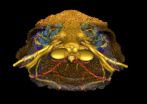(Press-News.org) A paper-based device that mimics the electrochemical signalling in the human brain has been created by a group of researchers from China.
The thin-film transistor (TFT) has been designed to replicate the junction between two neurons, known as a biological synapse, and could become a key component in the development of artificial neural networks, which could be utilised in a range of fields from robotics to computer processing.
The TFT, which has been presented today, 13 February, in IOP Publishing's journal Nanotechnology, is the latest device to be fabricated on paper, making the electronics more flexible, cheaper to produce and environmentally friendly.
The artificial synaptic TFT consisted of indium zinc oxide (IZO), as both a channel and a gate electrode, separated by a 550-nanometre-thick film of nanogranular silicon dioxide electrolyte, which was fabricated using a process known as chemical vapour deposition.
The design was specific to that of a biological synapse—a small gap that exists between adjoining neurons over which chemical and electrical signals are passed. It is through these synapses that neurons are able to pass signals and messages around the brain.
All neurons are electrically excitable, and can generate a 'spike' when the neuron's voltage changes by large enough amounts. These spikes cause signals to flow through the neurons which cause the first neuron to release chemicals, known as neurotransmitters, across the synapse, which are then received by the second neuron, passing the signal on.
Similar to these output spikes, the researchers applied a small voltage to the first electrode in their device which caused protons—acting as a neurotransmitter—from the silicon dioxide films to migrate towards the IZO channel opposite it.
As protons are positively charged, this caused negatively charged electrons to be attracted towards them in the IZO channel which subsequently allowed a current to flow through the channel, mimicking the passing on of a signal in a normal neuron.
As more and more neurotransmitters are passed across a synapse between two neurons in the brain, the connection between the two neurons becomes stronger and this forms the basis of how we learn and memorise things.
This phenomenon, known as synaptic plasticity, was demonstrated by the researchers in their own device. They found that when two short voltages were applied to the device in a short space of time, the second voltage was able to trigger a larger current in the IZO channel compared to the first applied voltage, as if it had 'remembered' the response from the first voltage.
Corresponding author of the study, Qing Wan, from the School of Electronic Science and Engineering, Nanjing University, said: 'A paper-based synapse could be used to build lightweight and biologically friendly artificial neural networks, and, at the same time, with the advantages of flexibility and biocompatibility, could be used to create the perfect organism–machine interface for many biological applications.'
INFORMATION:
From Thursday 12 February, this paper can be downloaded from http://iopscience.iop.org/0957-4484/25/9/094001/article
Notes to Editors
Contact
1. For further information, a full draft of the journal paper or contact with one of the researchers, contact IOP Press Officer, Michael Bishop:
Tel: 0117 930 1032
E-mail: michael.bishop@iop.org
For more information on how to use the embargoed material above, please refer to our embargo policy.
IOP Publishing Journalist Area
2. The IOP Publishing Journalist Area gives journalists access to embargoed press releases, advanced copies of papers, supplementary images and videos. In addition to this, a weekly news digest is uploaded into the Journalist Area every Friday, highlighting a selection of newsworthy papers set to be published in the following week.
Login details also give free access to IOPscience, IOP Publishing's journal platform.
To apply for a free subscription to this service, please email Michael Bishop, IOP Press Officer, michael.bishop@iop.org, with your name, organisation, address and a preferred username.
Low-voltage protonic/electronic hybrid indium zinc oxide synaptic transistors on paper substrates
3. The published version of the paper 'Low-voltage protonic/electronic hybrid indium zinc oxide synaptic transistors on paper substrates' (Guodong Wu et al 2014 Nanotechnology 25 094001) will be freely available online from 13 February 2014. It will be available at http://iopscience.iop.org/0957-4484/25/9/094001/article
Nanotechnology
4. Nanotechnology encompasses the understanding of the fundamental physics, chemistry, biology and technology of nanometre-scale objects.
IOP Publishing
5. IOP Publishing provides a range of journals, conference proceedings, magazines, websites, books and other services that enable researchers and research organisations to achieve the biggest impact for their work.
We combine the culture of a global learned society with highly efficient and effective publishing systems and processes. We serve researchers in the physical and related sciences in all parts of the world through our offices in the UK, US, Germany, China and Japan, and staff in many other locations including Mexico and Russia.
IOP Publishing is a wholly owned subsidiary of the Institute of Physics. The Institute is a leading international scientific society with over 55 thousand members promoting physics and bringing physicists together for the benefit of all.
Surplus generated by IOP Publishing is gift aided to the Institute to support science and scientists in both the developed and developing world.
Access to Research
6. Access to Research is an initiative through which the UK public can gain free, walk-in access to a wide range of academic articles and research at their local library. This article is freely available through this initiative. For more information, go to http://www.accesstoresearch.org.uk
The Institute of Physics
7. The Institute of Physics is a leading scientific society. We are a charitable organisation with a worldwide membership of more than 50,000, working together to advance physics education, research and application. We engage with policymakers and the general public to develop awareness and understanding of the value of physics and, through IOP Publishing, we are world leaders in professional scientific communications. Go to http://www.iop.org
Brain process takes paper shape
2014-02-13
ELSE PRESS RELEASES FROM THIS DATE:
Doctors are missing chance to diagnose COPD in up to 85 percent of cases, study finds
2014-02-13
A retrospective, 20-year study led by researchers at Plymouth University Peninsula Schools of Medicine and Dentistry shows that in up to 85 per cent of patients with chronic obstructive pulmonary disease (COPD) the underlying disease was being overlooked. Missed opportunities occur commonly in both primary and secondary care. The paper demonstrates the pointers to help GP to come to a earlier diagnosis. The findings are published in The Lancet Respiratory Medicine today, Thursday 13th February 2014.
The study encompassed almost 39,000 patients and showed that, in the ...
Cancer researchers discover pre-leukemic stem cell at root of AML, relapse
2014-02-13
(TORONTO, Canada – Feb. 12, 2014) – Cancer researchers led by stem cell scientist Dr. John Dick have discovered a pre-leukemic stem cell that may be the first step in initiating disease and also the culprit that evades therapy and triggers relapse in patients with acute myeloid leukemia (AML).
The research, published online today in Nature is a significant leap in understanding the steps that a normal cell has to go through as it turns into AML, says Dr. Dick, and sets the stage to advance personalized cancer medicine by potentially identifying individuals who might benefit ...
Jaw dropping: scientists reveal how vertebrates came to have a face
2014-02-13
A team of French and Swedish researchers have presented new fossil evidence for the origin of one of the most important and emotionally significant parts of our anatomy: the face. Using micron resolution X-ray imaging, they show how a series of fossils, with a 410 million year old armoured fish called Romundina at its centre, documents the step-by-step assembly of the face during the evolutionary transition from jawless to jawed vertebrates. The research is published in Nature on 12 February 2014.
Vertebrates, or backboned animals, come in two basic models: jawless and ...
Advanced techniques yield new insights into ribosome self-assembly
2014-02-13
CHAMPAIGN, Ill. — Ribosomes, the cellular machines that build proteins, are themselves made up of dozens of proteins and a few looping strands of RNA. A new study, reported in the journal Nature, offers new clues about how the ribosome, the master assembler of proteins, also assembles itself.
"The ribosome has more than 50 different parts – it has the complexity of a sewing machine in terms of the number of parts," said University of Illinois physics professor Taekjip Ha, who led the research with U. of I. chemistry professor Zaida Luthey-Schulten and Johns Hopkins University ...
Teledermatology app system offers efficiencies, reliably prioritizes inpatient consults
2014-02-13
PHILADELPHIA - A new Penn Medicine study shows that remote consultations from dermatologists using a secure smart phone app are reliable at prioritizing care for hospitalized patients with skin conditions. Researchers in the Perelman School of Medicine at the University of Pennsylvania report in JAMA Dermatology that this teledermatology process is reliable and can help deliver care more efficiently in busy academic hospitals and potentially in community hospital settings.
A national shortage and uneven distribution of dermatologists in the United States has caused scheduling ...
Stirring-up atomtronics in a quantum circuit
2014-02-13
VIDEO:
This is an animation showing a laser beam stirring a ring shaped quantum gas.
Click here for more information.
Atomtronics is an emerging technology whereby physicists use ensembles of atoms to build analogs to electronic circuit elements. Modern electronics relies on utilizing the charge properties of the electron. Using lasers and magnetic fields, atomic systems can be engineered to have behavior analogous to that of electrons, making them an exciting platform for studying ...
Ancient settlements and modern cities follow same rules of development, says CU-Boulder
2014-02-13
Recently derived equations that describe development patterns in modern urban areas appear to work equally well to describe ancient cities settled thousands of years ago, according to a new study led by a researcher at the University of Colorado Boulder.
"This study suggests that there is a level at which every human society is actually very similar," said Scott Ortman, assistant professor of anthropology at CU-Boulder and lead author of the study published in the journal PLOS ONE. "This awareness helps break down the barriers between the past and present and allows us ...
America's only Clovis skeleton had its genome mapped
2014-02-13
They lived in America about 13,000 years ago where they hunted mammoth, mastodons and giant bison with big spears. The Clovis people were not the first humans in America, but they represent the first humans with a wide expansion on the North American continent – until the culture mysteriously disappeared only a few hundred years after its origin. Who the Clovis people were and which present day humans they are related to has been discussed intensely and the issue has a key role in the discussion about how the Americas were peopled. Today there exists only one human skeleton ...
New target for psoriasis treatment discovered
2014-02-13
Researchers at King's College London have identified a new gene (PIM1), which could be an effective target for innovative treatments and therapies for the human autoimmune disease, psoriasis.
Psoriasis affects around 2 per cent of people in the UK and causes dry, red lesions on the skin which can become sore or itchy and can have significant impact on the sufferer's quality of life.
It is thought that psoriasis is caused by a problem with the body's immune system in which new skin cells are created too rapidly, causing a build up of flaky patches on the skin's surface. ...
Two parents with Alzheimer's disease? Disease may show up decades early on brain scans
2014-02-13
MINNEAPOLIS – People who are dementia-free but have two parents with Alzheimer's disease may show signs of the disease on brain scans decades before symptoms appear, according to a new study published in the February 12, 2014, online issue of Neurology®, the medical journal of the American Academy of Neurology.
"Studies show that by the time people come in for a diagnosis, there may be a large amount of irreversible brain damage already present," said study author Lisa Mosconi, PhD, with the New York University School of Medicine in New York. "This is why it is ideal ...



